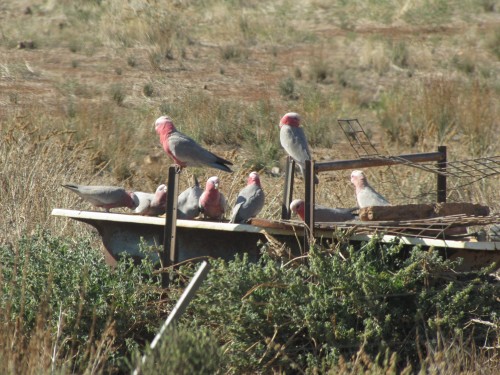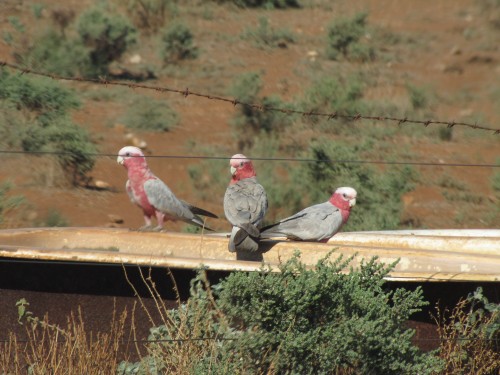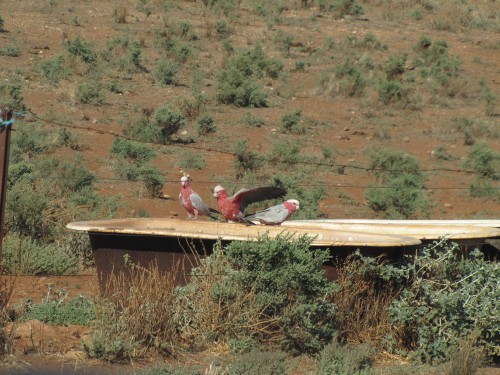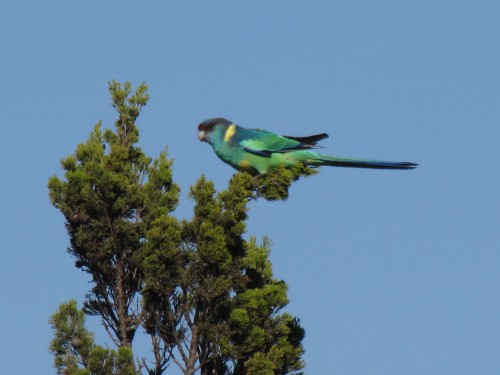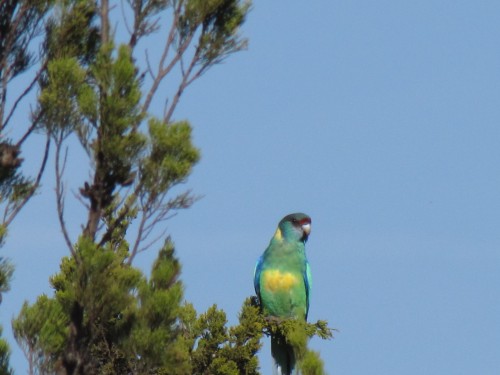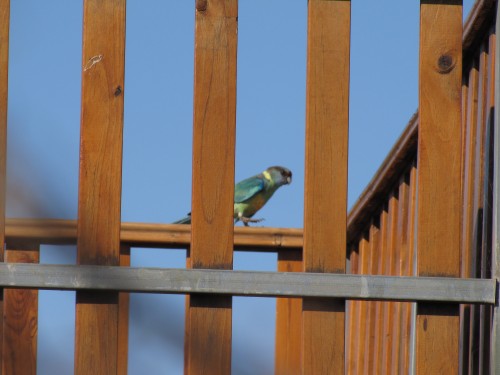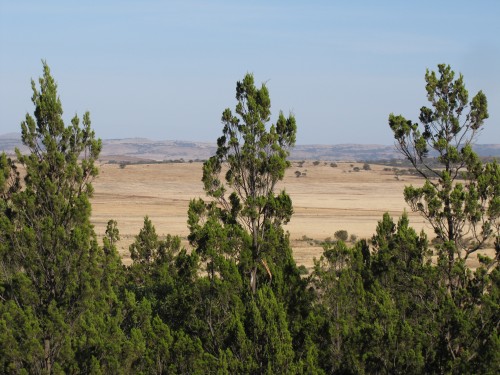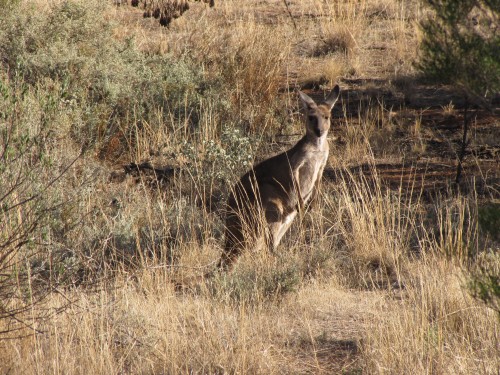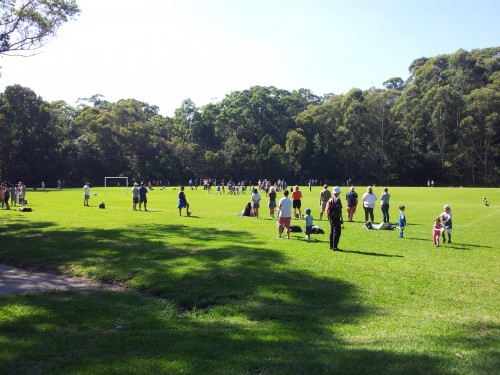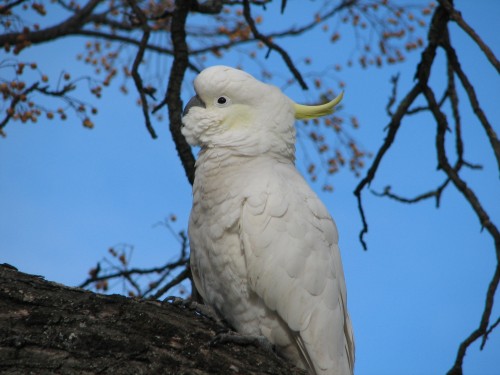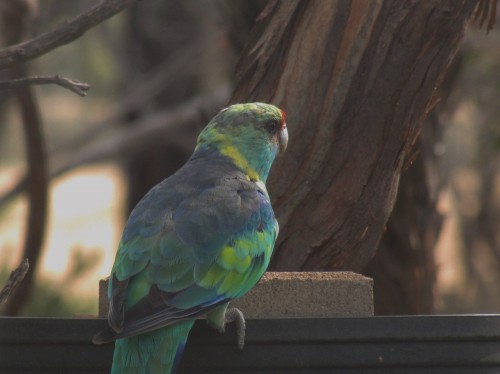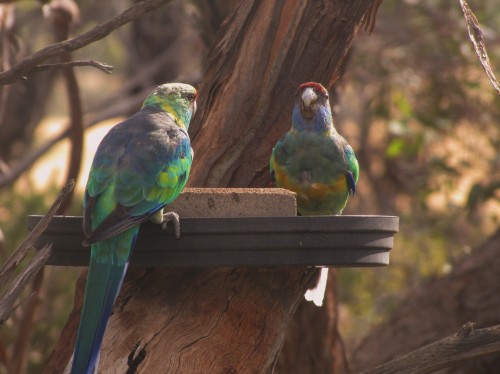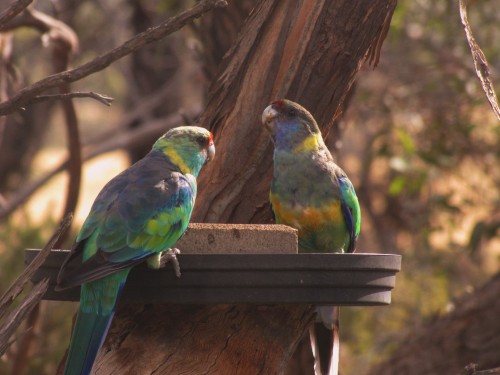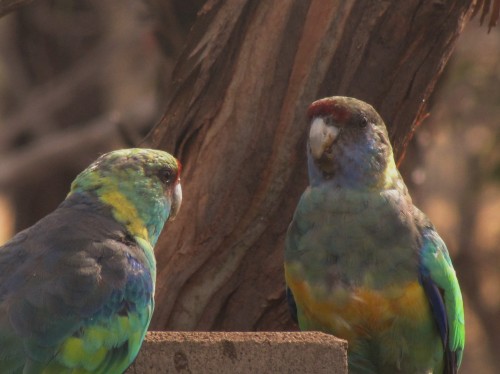A bunch of thirsty Galahs
In my post a few days ago I posted several photos of several Mallee Ringnecks taken just north of Peterborough in the mid-north of South Australia. As I left the reserve where I took those photos, I drove slowly along the dirt road back towards the town. I stopped several times to take a few photos of the local birds.
This was early in March and we were having a particularly hot spell of weather. By the time I had left the nature reserve, the air was beginning to really heat up. I thought that it might be prudent to head back to my brother-in-law’s home and lay low during the worst of the heat. On my way home, I spotted several small flocks of Galahs having a drink at several old baths in the nearby paddocks. The local farmers had placed these bath tubs in their horse paddocks, brought the water pipe to the bathtubs, installed floats and thus provided a water source for their horses and sheep.
Naturally, the Galahs have endorsed this installation by also indulging in an early morning drink before the heat of the day to come. The second photo (the one immediately below) is unfortunately spoiled by the thin line of the fencing wire passing across the face of two of the birds. I did not notice this when taking the photo. It was only when I downloaded the photo and enlarged it on my computer that I noticed the wire. Such are the hazards of photography.
A very noisy Mallee Ringneck
On the first weekend of March earlier this year my wife and I travelled to Peterborough in the mid-north of South Australia. My wife was attending a quilting seminar and we stayed with family while there. While she was attending the seminar I did a few hours of birding around town before the day became too hot.
The first place I ventured to was the Greg Duggan Reserve on Lookout Hill on the northern outskirts of town. This lookout gives a great view in all directions over the adjacent farming country surrounding the town. This small reserve is also a fine retreat for some of the local birds with over 70 species having been recorded there over the years. I had a good look around and managed a few good photos of a Western Grey Kangaroo (see photo below).
As I was leaving the lookout, which has a good ramp with wheelchair access, I heard the unmistakable and noisy call of a Mallee Ringneck Parrot. With very little effort I tracked it down and managed a few good photos which I have shown above and below. Next thing this bird was joined in a noisy duet with another bird which was walking along the railing of the lookout (see photo below). This chorus continued for several minutes before both birds flew off towards the town.
On our property in Murray Bridge, we have a noisy family of Mallee Ringneck parrots which are a resident breeding species in our garden. We get a little annoyed with them when they nibble at our pears as they are ripening on the trees. Mallee Ringnecks are a widespread species in the drier mallee areas of Australia. The Mallee Ringnecks are a sub-species of the Australian Ringneck, a widespread species with several other sub-species.
For more about the fauna of the Greg Duggan Reserve in Peterborough read my article called The Wildlife in the Greg Duggan Nature Reserve.
A little birding at soccer
We are currently staying with our son and his family in Artarmon, a suburb of Sydney. We try to get over here from Murray Bridge where we live at least once and preferably twice a year. While we are visiting I take every opportunity to do any incidental birding. There are significant differences in the range of bird species present here in Sydney when compared to at home.
On the last two Saturdays, we have had the opportunity to accompany our grandson to watch him play soccer. The photo above was taken with my phone at yesterday’s match. It was held on some pitches in Chatswood West, near the Lane Cove River. The match was a little uneven with my grandson’s team winning 10-0. He scored a goal, hit both upright posts and did a creditable job as the goalkeeper for the second half.
While I managed to mostly keep my eyes on the game from my folding chair, I was aware of some bird activity nearby. There were plenty of Noisy Miners nearby, their constant calling forming a backdrop to the noise of the game. My concentration on the game was tested on occasion when numerous raucous Sulphur-crested Cockatoos came wheeling overhead, landing in the trees surrounding the pitches.
After the game my wife and I found a comfortable garden seat near the playground adjacent to the soccer fields. This area was surrounded by many trees and bushes. While we sat there we were entertained by two Rainbow Lorikeets working at a hollow in a branch of a nearby tree. Within a few minutes a small flock of about 5 or 6 Sulphur-crested Cockatoos came into the same tree, squawking very noisily. The lorikeets vacated the hollow, their protesting screeches making the cockatoos know that they were far from happy. Several of the cockatoos inspected the hollow before leaving it. The hollow would have been too small for the much larger birds.
Other birds seen in the vicinity include:
- Australian Magpie
- Magpie Lark
- Common Myna
- Laughing Kookaburra
- Welcome Swallow
Now for the sad news.
I forgot to take my camera. The above photo was taken with my phone, but taking bird photos requires a much better camera setup than that. Had I remembered to bring my normal camera from home I would have managed to get some great shots of both the lorikeets and the cockatoos. The cockatoos had their yellow crests up on display for much of the time that we observed them. As well as those two species displaying for us, we also had a Laughing Kookaburra flying down to the lawn just in front of us to gobble up a tasty morsel for lunch.
For a moment, I thought I would be able to use my wife’s camera which was in the car. On opening up here camera bag, we found that the batteries were flat, including the spare set. Sigh. We will just have to return there while we are still here. In the meantime, I have included several photos of cockatoos and lorikeets taken elsewhere.
Mallee Ringnecks on a hot day
During the hot weather we have experienced so far this summer here in South Australia I have had many opportunities to take photos of the constant parade of birds visiting our bird baths. We have positioned the water containers where we can see the birds from our sun room, a room we use often so we can enjoy the birds in our garden.
The Mallee Ringnecks shown in today’s set of photos are resident birds in our garden. This means that we see them every day. On several occasions in recent times they have raised a brood of young ones. We love seeing their colourful feathers as they fly around the garden and especially when they come to drink and bathe. At those times we can really get to appreciate their colours up close.
On the other hand, we have a love-hate relationship with these birds. We hate it when they get into our fruit trees, nibbling at the almost ripened fruit before we have a chance to rescue the fruits of our labours. This year, because of a bad back, I have not been able to cover the trees with netting. Consequently the birds – and possibly the resident possums as well – have taken some of our fruit. We were especially looking forward to a large crop of nectarines. (Those we were able to rescue were delicious.) I must get to the pears before the birds get to them as well.
Further reading:
- Ringnecks and kites
- Mallee Ringnecks nesting
- A small birding accident
- The beautiful Eastern Rosella parrot
The enigmatic Night Parrot
The Night Parrot has long been thought to be extinct.
This has been the presumed status of the species for many decades. In fact, the majority of confirmed sightings were in the period 1870 to 1900. Since then, several dead birds have been found on roadsides and there have been tantalising reports of birders getting brief glimpses of the parrot in car headlights. The chance was always there; did it still exist in sustainable numbers – or any numbers at all?
On our many travels I will often challenge my wife to be on the lookout for two species when travelling at night: the Plains Wanderer and the Night Parrot. Sightings of either species would be most unlikely and being a supportive and loving person she agrees to keep a sharp eye on the lookout. We always enjoy this verbal banter with a little laughter.
However, the chances of seeing a Night Parrot have risen slightly in the last year or so. Ever so slightly. From 0% to approximately 0.001% – or thereabouts. Or to put it in Australian slang terms – from Buckley’s to Forget it!
Some facts we know about the Night Parrot:
- It is nocturnal – making it just that bit more difficult to observe.
- It’s preferred habitat in spinifex grasslands in the arid interior of Australia – that big space in the middle where very few travel and even fewer live, limiting chance sightings even further.
- It is small, green and yellow and dumpy, and runs and hops in preference to flying.
- It shelters in the clumps of the spinifex during the day making it almost impossible to find during the day – unless stepped on. Which you wouldn’t want to do to such a rare bird.
- It has never been filmed – until recently.
- Not much is known about the habits of the species, but that is about to change.
Rediscovery
After well over 17,000 hours of field work over the span of a decade, this species was rediscovered and filmed by John Young.
In 2013 naturalist and wildlife photographer John Young captured several photos and a few seconds of video footage of a live bird in western Queensland.
After a search spanning many years, John was finally rewarded by an incredibly close-up encounter with a Night Parrot – often considered the ‘holy grail’ for birdwatchers and naturalists.
Global interest in the discovery was so intense that the exact location of this only known population remains a closely guarded secret to protect the birds from disturbance.
Quoted from the Bush Heritage Australia website.
What is interesting about the Bush Heritage article is the 3:34 minute video showing the bird and the habitat in which it lives, plus more information about efforts to conserve the area. There is also an appeal to raise money in this important conservation project.
I am sorry that I do not have a photo of my own to share with you. My wife will just have to keep looking.
Further reading:
- Bush Heritage Australia – read more about this interesting bird, watch a short video and donate to the project to preserve the bird’s environment.
- Looking for a Night Parrot in a Haystack? A recent report in The Australian newspaper.
